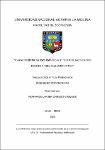Mostrar el registro sencillo del ítem
Características espermáticas y testiculares en dos edades y tres razas de cuyes
| dc.contributor.advisor | Alvarado Malca, Armando Enrique | |
| dc.contributor.author | Orrego Vásquez, Fernando Javier | |
| dc.date.accessioned | 2023-02-13T19:27:13Z | |
| dc.date.available | 2023-02-13T19:27:13Z | |
| dc.date.issued | 2022 | |
| dc.identifier.uri | https://hdl.handle.net/20.500.12996/5644 | |
| dc.description | Universidad Nacional Agraria La Molina. Facultad de Zootecnia. Departamento Académico de Producción Animal | es_PE |
| dc.description.abstract | La crianza de cuyes ha tenido un desarrollo progresivo durante los últimos años, con criadores que buscan bases genéticas mejoradas que les permitan mejorar su productividad. El objetivo del presente estudio fue caracterizar el desarrollo testicular y los valores seminales de tres razas de cuyes y un grupo control mediante las mediciones testiculares, el recuento de células testiculares y la colección espermática de la cola del epidídimo. Se realizó en el Programa Nacional de Cuyes del Instituto Nacional de Innovación Agraria, utilizándose 40 machos beneficiados. Se diseccionaron los testículos para realizar las mediciones y cortes histológicos, y mediante el procedimiento del “swim out” se realizaron cortes en el epidídimo para colectar los espermatozoides. Los valores promedio de peso, largo, ancho y volumen testicular fueron 5.53g, 2.00cm, 1.59cm y 2.67cm3 respectivamente. Se encontraron diferencias significativas entre razas para dimensiones testiculares, mostrando en general la raza Perú un mayor peso, ancho y volumen frente al grupo control, y es similar a la raza Andina. Con respecto a la edad, se hallaron diferencias entre las 14 y 16 semanas en el largo testicular. El valor promedio de recuento espermático fue de 156.10x106 células/ml, y la motilidad individual fue de 45%. El grupo control tiene mayor motilidad individual frente a las tres razas, y entre edades se hallaron diferencias en el recuento espermático. Se evidenció presencia de espermatozoides en el túbulo en el 100% de los animales muestreados. Los valores promedios de espermatogonias, espermatocitos, espermátides, células de Sertoli y de Leydig fueron de 2765.00, 6772.00, 6542.50, 4022.50 y 1950.00 células/mm2 respectivamente. Se observaron diferencias para las células de Sertoli entre razas, donde las razas Perú, Andina e Inti eran superiores al grupo control. Se obtuvieron correlaciones moderadas entre peso vivo y dimensiones testiculares, así como entre células de Sertoli con espermatocitos y espermátides. | es_PE |
| dc.description.abstract | Guinea pig breeding has had a progressive development in recent years, with breeders looking for improved genetic bases that allow them to increase their productivity. The aim of this study is to characterize testicular development and seminal values of three guinea pig breeds (Perú, Andina and Inti) and a control group using testicular measurements, testicular cell counts and sperm collection from the tail of the epididymis. It was realized in the Programa Nacional de Cuyes of the Instituto Nacional de Innovación Agraria, using 40 slaughtered males. The testicles were dissected to realize measurements and histological cuts, and using the “swim out” procedure, the epididymis was cut to collect the spermatozoa. The average values of testicular weight, length, width, and volume were 5.53g, 2.00cm, 1.59cm and 2.67cm3 respectively. Significant differences were found between breed for testicular dimensions, the Perú breed had greater weight, width and volume compared to the control group, and it is similar to the Andina breed. Differences were found between 14 and 16 weeks in testicular length. The average sperm count value was 156.10x106 cells/ml, and individual motility was 45%. The control group has greater individual motility compared to the three breeds, and differences were found between ages in sperm count. The presence of spermatozoa in the tubule was evidenced in 100% of the sampled animals. The average values of spermatogonia, spermatocytes, spermatids, Sertoli and Leydig cells were 2765.00, 6772.00, 6542.50, 4022.50 and 1950.00 cells/mm2 respectively. Differences were observed for Sertoli cells between breeds, where the Perú, Andina and Inti breeds were superior to the control group. Moderate correlations were obtained between body weight and testicular dimensions, and between Sertoli cells with spermatocytes and spermatids. | en_US |
| dc.format | application/pdf | en_US |
| dc.language.iso | spa | es_PE |
| dc.publisher | Universidad Nacional Agraria La Molina | es_PE |
| dc.rights | info:eu-repo/semantics/openAccess | en_US |
| dc.rights.uri | https://creativecommons.org/licenses/by-nc-nd/4.0/ | * |
| dc.subject | Cuyes | es_PE |
| dc.subject | Características espermáticas | es_PE |
| dc.subject | Espermatozoo | es_PE |
| dc.subject | Evaluación | es_PE |
| dc.subject | Perú | es_PE |
| dc.subject | Selección espermática | es_PE |
| dc.subject | Selección | es_PE |
| dc.title | Características espermáticas y testiculares en dos edades y tres razas de cuyes | es_PE |
| dc.type | info:eu-repo/semantics/bachelorThesis | en_US |
| thesis.degree.discipline | Zootecnia | es_PE |
| thesis.degree.grantor | Universidad Nacional Agraria La Molina. Facultad de Zootecnia | es_PE |
| thesis.degree.name | Ingeniero Zootecnista | es_PE |
| dc.subject.ocde | https://purl.org/pe-repo/ocde/ford#4.02.01 | es_PE |
| renati.author.dni | 71115956 | es_PE |
| dc.publisher.country | PE | es_PE |
| dc.type.version | info:eu-repo/semantics/publishedVersion | en_US |
| renati.advisor.orcid | https://orcid.org/0000-0003-0068-4345 | es_PE |
| renati.advisor.dni | 07709151 | es_PE |
| renati.type | https://purl.org/pe-repo/renati/type#tesis | es_PE |
| renati.level | https://purl.org/pe-repo/renati/level#tituloProfesional | es_PE |
| renati.discipline | 811306 | es_PE |
| renati.juror | Cabrera Villanueva, Próspero | |
| renati.juror | Gutiérrez Reynoso, Gustavo | |
| renati.juror | Gallegos Cárdenas, Amalia |
Ficheros en el ítem
Este ítem aparece en la(s) siguiente(s) colección(ones)
-
ZOO-PA Tesis [161]





